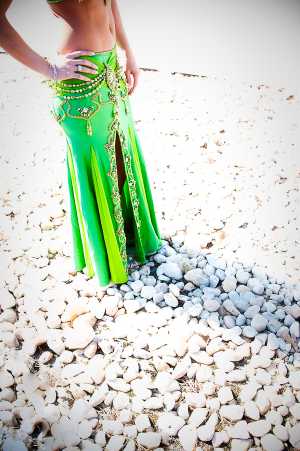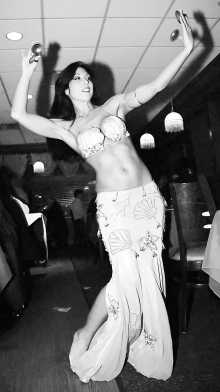
What do you see when you imagine belly dancing?
It’s Probably Not What You Think.
The belly dance is not a dance of seduction — nor did it begin that way. Throughout Middle Eastern history, Oriental dance (the proper term for belly dance) has been a family dance done at such occasions as weddings, births, and festivals. Men, women, and children in those cultures have always belly danced for fun, not to entertain or arouse an audience.
You’ve Come A Long Way, Baby.
Belly dancing may have originated as a fertility ritual. 17,000 year-old rock engravings found in the caves of Addaura, near Palermo in Sicily, depict what appears to be a ritual fertility dance, as do ancient Egyptian tomb paintings and Greek sculptures.
In Sparta, women danced for Artemis, who was a goddess of the moon and of fertility. Referred to as the Kordax, their dance emphasized the rotation of the hips and stomach. Hebrews, on the other hand, danced the Shalome — a dance based on a legend whose heroine embodied both motherhood and fruitfulness: the myth of the Seven Veils of Ishtar (more on that later).
Many early civilizations believed that women were almost solely responsible for procreation. In some cases, women were feared because they seemed to command the mysteries of nature. Tribes in the South Seas, New Guinea, East Polynesia, Africa, and Greece not only thought that conception would be impossible, but that the human race would die — unless the women performed the fertility dance.
The Dance of the Seven Veils
Consider the myth of the Seven Veils of Ishtar. This legend began in 4,500 BC, out of fear that winter might never end. It’s a tale found, with variations, in a number of different cultures. The essential idea of a ” belly dancing” woman, however, remains intact in all.
A Babylonian goddess of love and sensuality, Ishtar represented all women. She was chaste, yet fertile. She was a life-giver and a great nurturer, yet she was known as the mother of darkness and destruction.
According to the story, Ishtar’s husband dies and descends into the land of darkness, (in some cases referred to as the ” womb of the Earth” ). Ishtar covers her body with seven veiled costumes, and sets off to retrieve her husband.
Appropriately dressed, she deceives her way into the underworld, through forty-nine gates. To gain admission at each seventh gate, she dances in a way that emphasizes her abdomen, rolling it in circles. Each time she does so, she gives up a jewel and a veil.

Meanwhile, in her absence, no crops grow, and no festivities take place. Ishtar makes her way through the gates, determined to reach the forty-ninth — and determined to find her man. Despite the hardships, Ishtar triumphs. When she returns with her husband and her seven veils, the people celebrate and the crops flourish.
Meet the Mothers.
In traditional Muslim society, women often gathered to perform a type of belly dance after the evening meal, a dance they called ” Raks-sharki” . After feeding their husbands and sons, the women would convene in a separate location to dance (such activity was not permitted in the company of men).
That traditional, “after dinner” dance was important because it enabled mothers of eligible bachelors to meet the young women in the community. It also developed the muscles needed for childbirth. As such, young women displayed their readiness for marriage by dancing for the mothers.
How Belly Dance Became Westernized
Eighteenth century French explorers traveling in Egypt witnessed performers of a curious dance, which these Frenchmen termed ” dance du ventre” (” dance of the stomach” ). The French painter Delacroix, on a visit to North Africa in 1832, made this observation about the dancers:
” They are closer to nature in a thousand ways. Their dress, the form of their shoes. And so beauty has a share in everything they make. As for us in our corsets, our tight shoes, our ridiculous pinching clothes, we are pitiful.”
Coming to America
Belly dancing was introduced to America in 1893, by promoter Sol Bloom, at the Chicago World’s Fair. Some credit Bloom with coining the term ” belly dance” , a term he used to call attention to the exotic-looking dancers (remember that this was an era in which a woman’s exposed ankle was considered shocking). The dance was an immediate hit. It spread to Coney Island in 1908, and soon moved on to other major metropolitan areas.
Of course, given the social climate, the dance was not always well received. The Victorian women of the late 1800s, dressed head to toe in corsets and layered gowns, were repulsed by such ” obscenity”.
The Cart Pulls The Horse.
Western colonialists from Europe influenced many parts of the Middle East. In some countries, men and women broke with tradition and began socializing in mixed company. Nightclubs sprung up, which led to a newly Westernized belly dance — replete with the sequined bra/belt combination created by Hollywood movie makers — as a form of entertainment. In fact, many credit the film industry, especially the Egyptian film industry, with changing Middle Eastern belly dance into what it is today.
You Oughta Be In Pictures.

In the eighteenth century, Egypt was a British colony, so when movie making began in the West, an Egyptian film industry quickly developed (no pun intended). Screen writers, looking for new ideas, were intrigued by the informal dancing seen throughout Egypt.
Many talented dancers were recruited, dressed in costumes, and put in movie dance scenes. Soon, Hollywood conceptions of entertainment and glamour changed both the nature of the dancing and the costumes. Such dancers as Samia Gamal and Tahia Carioca quickly became international stars.
A new type of belly dancer emerged, one who would perform on-stage in the clubs and cabarets of Cairo. Such dancers inspired many Westerners to appreciate (and even learn) the dance. And that’s why belly dancing is sometimes referred to as ” Egyptian Dance”.
Belly Dance Today
The Veil Prevails.
Throughout the history of the belly dance, veils have been worn to conceal the body, which symbolizes both sexuality and worldliness. In Muslim society, modern Arab women are still required to wear veils in obedience to Islam.
As belly dancing has become accepted in some of its originating countries, however, it has been ever more common at weddings, birth announcements, and other important celebrations. In present-day Egypt, in fact, it’s customary for a newlywed couple not only to hire a belly dancer for their wedding, but also to have their photo taken with their hands on the dancer’s stomach — another throwback to the dance’s significance as a fertility rite.
Men, women, and children all belly dance at such events, although the men and women dance in separate groups, with arms outstretched (though all will sometimes dance in a circle formation).
Bring On the Dance!
In many parts of the world, travelers and locals alike fully expect to see a belly dance. You won’t experience typical Moroccan nightlife without participating in one. Similarly, it’s nearly impossible to visit Hawaii and not see its native belly dance: the Hula. The latter, in fact, derives from the Polynesian form of belly dancing, which arrived with Hawaii’s earliest settlers back in the fifth century.
Belly Dance Retakes The West.
Interest in belly dancing has surged in recent years. Some attribute that to an influx of immigrants, now free to enjoy their native dance in Middle Eastern restaurants in the West. The belly dance has been a standard form of entertainment at such venues in American cities since the 1960s.
We Can Work It Out.
Belly dancing has also swept the exercise industry. The dance strengthens the abdominals, thighs, calves, arms, back, buttocks, and hips. Under-exercised muscles, which are otherwise hard to tone via traditional methods, respond rapidly to belly dance.
Participants can even correct poor posture with the dance’s unique, isolated movements. And because people usually find it more interesting than most other forms of exercise, it’s become an enjoyable and sustainable way to lose weight and tone muscles — for those of nearly any age group or fitness level.
Not surprisingly, it can even be used during pregnancy — through the third trimester — to ready the stomach muscles for childbirth.
As it has for thousands of years, the belly dance thrives. In both the West and the Middle East, professional dancers perform at nightclubs, weddings, and other events. But the ancient art of Oriental dance is still seen, in many parts of the Middle East, as an informal dance, one that people of all ages do for fun when with friends and family. And it is a dance that you can learn to do for fun, entertainment, or fitness.